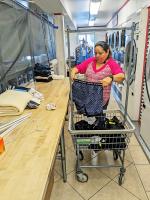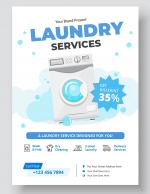CHICAGO — Increased volume and more specialized cleaning needs and demands are just a couple differences linked to taking on business-focused commercial laundry service. Residential wash-dry-fold service has become a staple for many laundromats and broadening a service menu to also include commercial accounts can generate greater revenue.
But it’s important to recognize the distinctions between the two customer types. What a commercial customer wants or needs can be quite different from a family of four with their everyday garments, potentially placing new stresses on a laundry provider.
American Coin-Op spoke to a trio of laundry operators with a variety of experience about their take on commercial laundering at their scale and what they’ve learned to do it successfully. In Part 1, we heard from Brian Henderson of Liberty Laundry in Oklahoma. Here in Part 2 let’s hear from Kelly Castillo in California.
KELLY CASTILLO, BUBBLES LAUNDRY SERVICE
Castillo and her partner purchased an inactive unattended laundromat in an Anaheim, California, shopping center in April 2022. “And when we did that, we always had the mindset that we would be revamping it, and in order to support that, we would have to offer wash-dry-fold to residential and commercial customers. It was part of our business plan from day one.”
The City of Anaheim has a law stating that all laundromats must be attended while open, she says. “We thought, ‘How can we run this and cover the payroll?’ We realized pretty quickly that we would need to offer services in order to be solvent.”
To run Bubbles Laundry Service, a manager with direct experience was hired. “She’s been in the laundry business for two decades. She helped us tremendously. We have three drivers and, I want to say, seven attendants right now.”
Several months had passed after the purchase before owners felt comfortable beginning to offer pickup and delivery. “As soon as we had enough reliable machines that we felt we could be processing orders. We only had so many working machines at the time, because they were in such bad shape.”
After having renovated and reequipped the 1,500-square-foot laundromat bit by bit, everything there from the 44 washers and 36 dryers to coin changers and the point-of-sale system is “brand-new,” Castillo says.
Looking back, while offering to serve commercial customers through Bubbles, the owners didn’t actively pursue that business in the beginning.
“When we built the website, we did add a commercial component to it — there is a section about commercial service — but we weren’t pushing it at that time. We didn’t know what we were doing. I understand residential laundry … but commercial laundry, I wasn’t sure how that worked.”
Much time and effort was put into training staff how to properly process and fold laundry. Everyone on staff, even the drivers, are trained in doing the work.
“Commercial clients, especially, expect consistency, even maybe more so than residential clients,” Castillo says.
Their first B2B account came about through a residential customer. She worked for an Orange County high school and asked if Bubbles could launder the football team’s uniforms.
Today, Bubbles actively seeks to fulfill the laundry chores of gyms and spas; restaurants and caterers; hotels; medical clients; long-term care facilities; and more. Its commercial poundage outpaces residential roughly 60 to 40, according to Castillo.
“(Commercial work is) actually easier (to process) than residential because everything is the same. You’re not folding four different family members’ sizes of clothing, some towels, some sheets, the tiny little toddler underwear. It’s harder to fold a residential order than a spa’s order of plain white towels.”
Plus there’s the consistency factor: “When you have a commercial client, you can rely on every week that they’re going to process this much laundry. … We send those invoices out on the first of the month and they pay them quickly. They complain much less than residential customers.”
Taking on commercial work meant more space was needed to accept and store the goods.
“I realized this was something in our wheelhouse that we could do, we just needed a little bit more space for storage,” she says. “A lot of our commercial clients are once a week pickups, so we would be storing these items between services.”
Bubbles contacted the landlord and requested they alert them if the neighbor next door, a nail salon of about 700 square feet, asked out of its lease. Within a month or so, the call came, Castillo says.
“We took over the space next door. It’s connected in the back of our laundromat by our break room. We don’t have it open to the public. There’s a few machines in there [four washers and a large commercial dryer] but otherwise it’s just storage for all of our commercial and government contracts.”
From the outset, what was your biggest challenge in taking on the commercial laundry focus?
“I think everyone’s biggest challenge is finding customers in the beginning,” Castillo says. “When you’re just starting out, most (commercial) customers want references, they want to know you’ve done this kind of work before. So that can be difficult to overcome.”
Another big challenge has been billing and seeking payment from business clients whose operations may be struggling financially.
“We try to be as understanding as we possibly can. We give a lot of leeway,” she says. “I’m paying my employees on time for the order that they processed. I’m paying commissions to my employees, which was another challenge. But that all comes out of pocket and when it takes a customer sometimes months to pay us, it’s not a great feeling.”
If given the chance to start the commercial wash-dry-fold effort anew, Castillo says she would design the company website to more evenly promote Bubbles’ residential and commercial laundry capabilities.
Plus, she warns anyone pursuing a similar path to be prepared as far as cash flow is concerned.
“Most commercial clients expect to be billed monthly on a net 30, so if you cannot carry the cost of that laundry for as much as 60 days or more … it could put you in a really bad position.”
Coming Tuesday in the conclusion: Meet Sharon Brinks from Laundry Station/Laundry Express in Kansas
Have a question or comment? E-mail our editor Bruce Beggs at [email protected].






















